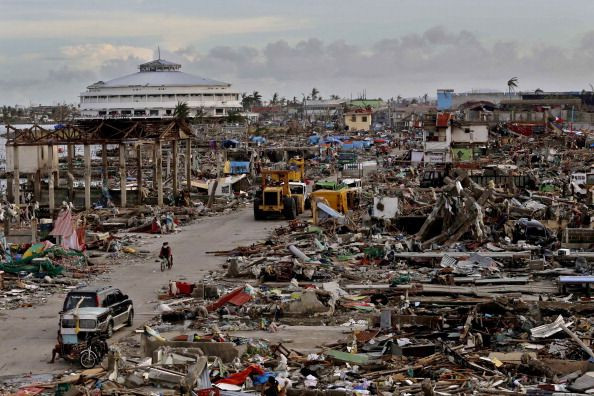Philippines Super Typhoon: This Is Only The Beginning Of Far Worse Natural Catastrophes

Super-typhoon Haiyan, one of the strongest storms in recorded history which has carved a path of horrific destruction across Central Philippines, killing untold thousands of people and displacing hundreds of thousands of others, may only serve as a harbinger of far deadlier natural disasters for the East Asian nation. According to the Phillipines government’s Climate Change Commission (CCC), Haiyan (or Yolanda as the Filipinos call her) is the result of climate change and will be followed by many more storms of even greater destructive power in the years and decades to come.
Commission head Lucille Sering, attending the United Nations Climate Change Conference in Warsaw, Poland, told the Manila Times: “Extreme weather is becoming more frequent, it is now the new norm. With Yolanda, it was a deadly combination. High temperatures took more water to the atmosphere so it brought more rains while strong winds pushed ocean water ashore. You wouldn’t stand a chance. Its strength was off the charts.” Sering also noted that the Philippines is hardly the only nation suffering from the effects of climate change, mentioning that sea levels are rising across the islands in the Caribbean Sea and the Pacific Ocean as well.
However, as a report in The Guardian pointed out, the Philippines’ location and topography makes the archipelago nation of more than 7,000 islands particularly vulnerable to the effects of global warming, describing it as “ill-starred” and “lying prone and vulnerable at the windswept eastern end of the Pacific.” On average, The Philippines is bombarded by 20 typhoons, including three super-typhoons, annually. The nation of far-flung islands also endures any number of floods, droughts, earthquakes and volcanic eruptions every year. According to the UN Office for Coordination of Humanitarian Affairs (OCHA), 182 natural disasters have struck the Philippines since 2002, killing nearly 11,000 people. The Guardian noted that this figure does not even include the latest super-typhoon Haiyan nor typhoon Bopha which hit last December and killed more than 1,000. Bopha (called Pablo by the Filipinos) featured wind speeds of up to 160 mph, and wind gusts of 195 mph, making it the deadliest typhoon in the world last year. The figures from Haiyan suggest it was even deadlier and more powerful than Bopha.
"Last year one typhoon [Bopha] hurt us very much,” Sering told the Guardian (prior to Haiyan). “If this continues we are looking at a big drain on resources." Indeed, the Phillipines is also a poor and underdeveloped country with poor infrastructure – and it will need significant financial investments to enact proper disaster relief measures. In 2009, costs connected with natural disaster clean up amounted to almost 3 percent of GDP.
“More extreme weather events are more likely to occur in the future… what we’re saying in Warsaw is that developing countries such as the Philippines cannot do it on their own. This will somehow provide a motivation for them to act now,” Sering said to the Times. “We will not make a plea or beg. But we will point out that the Philippines, through Yolanda, has served as a warning system for the worse things to come.” Indeed, government officials estimate that mean temperatures in the country are climbing by 0.14 Centigrade each year.
Another Filipino official attending the Warsaw conference, climate change commissioner Naderev Sano, told the delegates: “What my country is going through as a result of this extreme climate event is madness. The climate crisis is madness.”
Separately, officials in the Philippines capital of Manila (a metro area of some 12 million people), are wondering what would happen if a typhoon as strong as Haiyan hit the city. Architect Felino “Jun” Palafox Jr. told the Manila Times that such an event would be catastrophic, destroying many buildings, leading to far worse casualties than those recorded in the center of the Haiyan disaster’s impact, the Visayas islands in the central part of the country, far south of Manila. Palafox equated the magnitude of Haiyan to the destructive impact that a 7.2-magnitude earthquake would have on Manila. “The government should conduct structural audit immediately. We should update the building code now,” he said. “But in case there will be strong winds, our buildings are not ready for it, they are not designed well.”
© Copyright IBTimes 2024. All rights reserved.





















